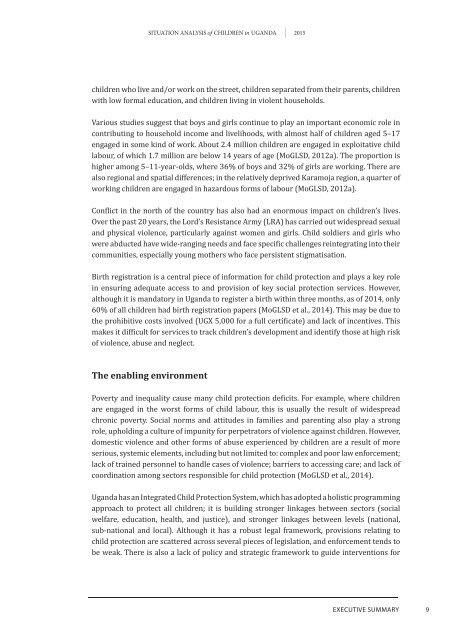Situation analySiS
1TNu802
1TNu802
Create successful ePaper yourself
Turn your PDF publications into a flip-book with our unique Google optimized e-Paper software.
<strong>Situation</strong> <strong>analySiS</strong> of Children in uganda 2015children who live and/or work on the street, children separated from their parents, childrenwith low formal education, and children living in violent households.Various studies suggest that boys and girls continue to play an important economic role incontributing to household income and livelihoods, with almost half of children aged 5–17engaged in some kind of work. About 2.4 million children are engaged in exploitative childlabour, of which 1.7 million are below 14 years of age (MoGLSD, 2012a). The proportion ishigher among 5–11-year-olds, where 36% of boys and 32% of girls are working. There arealso regional and spatial differences; in the relatively deprived Karamoja region, a quarter ofworking children are engaged in hazardous forms of labour (MoGLSD, 2012a).Conflict in the north of the country has also had an enormous impact on children’s lives.Over the past 20 years, the Lord’s Resistance Army (LRA) has carried out widespread sexualand physical violence, particularly against women and girls. Child soldiers and girls whowere abducted have wide-ranging needs and face specific challenges reintegrating into theircommunities, especially young mothers who face persistent stigmatisation.Birth registration is a central piece of information for child protection and plays a key rolein ensuring adequate access to and provision of key social protection services. However,although it is mandatory in Uganda to register a birth within three months, as of 2014, only60% of all children had birth registration papers (MoGLSD et al., 2014). This may be due tothe prohibitive costs involved (UGX 5,000 for a full certificate) and lack of incentives. Thismakes it difficult for services to track children’s development and identify those at high riskof violence, abuse and neglect.The enabling environmentPoverty and inequality cause many child protection deficits. For example, where childrenare engaged in the worst forms of child labour, this is usually the result of widespreadchronic poverty. Social norms and attitudes in families and parenting also play a strongrole, upholding a culture of impunity for perpetrators of violence against children. However,domestic violence and other forms of abuse experienced by children are a result of moreserious, systemic elements, including but not limited to: complex and poor law enforcement;lack of trained personnel to handle cases of violence; barriers to accessing care; and lack ofcoordination among sectors responsible for child protection (MoGLSD et al., 2014).Uganda has an Integrated Child Protection System, which has adopted a holistic programmingapproach to protect all children; it is building stronger linkages between sectors (socialwelfare, education, health, and justice), and stronger linkages between levels (national,sub-national and local). Although it has a robust legal framework, provisions relating tochild protection are scattered across several pieces of legislation, and enforcement tends tobe weak. There is also a lack of policy and strategic framework to guide interventions forExECUtIvE SUMMary9




